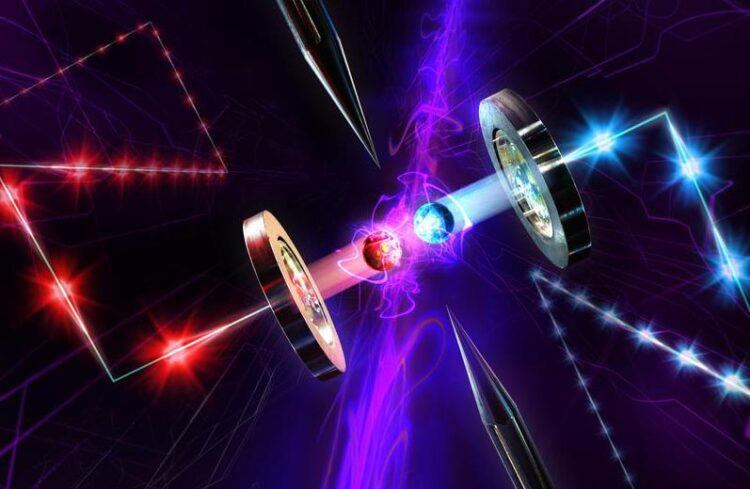Boost for the quantum internet

In order to transmit quantum information over long distances, so-called quantum repeaters are needed to distribute entanglement over long distances.
(c) Harald Ritsch / Universität Innsbruck
First long-distance quantum repeater node for telecommunication networks.
A quarter of a century ago, theoretical physicists at the University of Innsbruck, Austria, made the first proposal on how to transmit quantum information via quantum repeaters over long distances which would open the door to the construction of a worldwide quantum information network. Now, a new generation of researchers at the University of Innsbruck has built a quantum repeater node for the standard wavelength of telecommunication networks and transmitted quantum information over tens of kilometers.
Quantum networks connect quantum processors or quantum sensors with each other. This allows tap-proof communication and high-performance distributed sensor networks. Between network nodes, quantum information is exchanged by photons that travel through optical waveguides. Over long distances, however, the likelihood of photons being lost increases dramatically. As quantum information cannot simply be copied and amplified, 25 years ago Hans Briegel, Wolfgang Dür, Ignacio Cirac and Peter Zoller, then all at the University of Innsbruck, provided the blueprints for a quantum repeater. These feature light-matter entanglement sources and memories to create entanglement in independent network links that are connected between them by a so-called entanglement swap to finally distribute entanglement over long distances.
Even transmission over 800 kilometers possible
Quantum physicists led by Ben Lanyon from the Department of Experimental Physics at the University of Innsbruck have now succeeded in building the core parts of a quantum repeater — a fully functioning network node made with two single matter systems enabling entanglement creation with a photon at the standard frequency of the telecommunications network and entanglement swapping operations. The repeater node consists of two calcium ions captured in an ion trap within an optical resonator as well as single photon conversion to the telecom wavelength. The scientists thus demonstrated the transfer of quantum information over a 50-kilometer-long optical fiber, with the quantum repeater placed exactly halfway between starting and end point. The researchers were also able to calculate which improvements of this design would be necessary to make transmission over 800 kilometers possible which would allow to connect Innsbruck to Vienna.
The current results were published in Physical Review Letters. Funding for the research was provided by a START award from the Austrian Science Fund FWF, the Austrian Academy of Sciences and the European Union, among others. Lanyon’s team is part of the Quantum Internet Alliance, an international project under the EU Quantum Flagship.
Wissenschaftliche Ansprechpartner:
Ben Lanyon
Department of Experimental Physics
University of Innsbruck
+43 512 507 52900
ben.lanyon@uibk.ac.at
https://www.quantumoptics.at
Originalpublikation:
Telecom-wavelength quantum repeater node based on a trapped-ion processor. V. Krutyanskiy, M. Canteri, M. Meraner, J. Bate, V. Krcmarsky, J. Schupp, N. Sangouard, and B. P. Lanyon. Phys. Rev. Lett. 130, 213601 DOI: https://doi.org/10.1103/PhysRevLett.130.213601 [arXiv: https://arxiv.org/abs/2210.05418v2]
Quantum Repeaters: The Role of Imperfect Local Operations in Quantum Communication
H.-J. Briegel, W. Dür, J. I. Cirac, and P. Zoller. Phys. Rev. Lett. 81, 5932 – Published 28 December 1998 https://doi.org/10.1103/PhysRevLett.81.5932 [arXiv: https://arxiv.org/abs/quant-ph/9803056]
Weitere Informationen:
https://physics.aps.org/articles/v16/84 – Physics: Quantum Repeater Goes the Distance
Media Contact
All latest news from the category: Information Technology
Here you can find a summary of innovations in the fields of information and data processing and up-to-date developments on IT equipment and hardware.
This area covers topics such as IT services, IT architectures, IT management and telecommunications.
Newest articles
Faster, more energy-efficient way to manufacture an industrially important chemical
Zirconium combined with silicon nitride enhances the conversion of propane — present in natural gas — needed to create in-demand plastic, polypropylene. Polypropylene is a common type of plastic found…

Energy planning in Ghana as a role model for the world
Improving the resilience of energy systems in the Global South. What criteria should we use to better plan for resilient energy systems? How do socio-economic, technical and climate change related…

Artificial blood vessels could improve heart bypass outcomes
Artificial blood vessels could improve heart bypass outcomes. 3D-printed blood vessels, which closely mimic the properties of human veins, could transform the treatment of cardiovascular diseases. Strong, flexible, gel-like tubes…





















